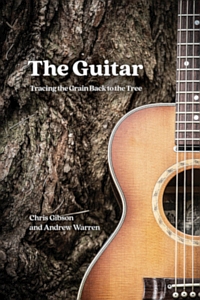There is no other instrument that so profoundly influenced contemporary popular music, than the guitar. In its electrified version it has coined modern pop, and naturally rock music from the 1950s onward.
 Authors Gibson and Warren – who are neither music historians, luthiers nor professional musicians, but geographers and economic geographers from the University of Wollongong, Australia – trace the instrument’s history, or rather, “the grain back to the tree,” quite literally.
Authors Gibson and Warren – who are neither music historians, luthiers nor professional musicians, but geographers and economic geographers from the University of Wollongong, Australia – trace the instrument’s history, or rather, “the grain back to the tree,” quite literally.
They travel backward in time, in a way. In this case, it means journeys both to different continents, as well as a journey back to the old art and craft of instrument manufacturing. The art of “lutherie,” i.e. guitar building, was achieved in diverse regions at various times. They also share a lot of information on distinctive aspects of the respective trees, that would lend altogether different audio properties to the finished string instrument, and go deeply into the ecological aspects of growing, harvesting, selecting, storing, drying and shaping the basic materials for the guitar.
Specific wood types, the authors realized while compiling their book, are currently extremely hard to find in certain regions, the result of ruthless exploitation, huge environmental problems, destruction of natural resources, and man-made destruction and disappearance of the natural resources required to grow healthy woods. Today, several wood types belong to endangered species or are close to that fate, also because of the strong demand for guitars worldwide.
They also chronicle the skills of those people involved in making guitars who usually remain unmentioned. “We committed to … documenting the lived experiences of factory workers, sawmillers, foresters, and indigenous custodians, and the shifting forces that shape working lives. We hoped that encountering firsthand the people, places, forests, and trees behind guitars would enable us to write as ‘an act of response, an effort to craft better worlds with others’. And so, … our goal crystallized: to start with the finished guitar and trace it, ‘in rewind,’ to its origin place, people and plants.”
Their six-year journey provided the data, lore, findings, and even adventurous results and at times bewildering conclusions of this book, as not all foresters, landowners and traders prefer a harmonious coexistence with nature, forests, the land and its indigenous people. The big players in the wood industry buy the timbers for the guitar’s body, bindings, fretboard, inlays, headstock, neck, back, saddle, bridge or soundboard from dozens of traders in dozens of countries. This also means purchases from regions with serious environmental problems, devastating histories of colonialism and old and current violence against indigenous people. All of that under pressure from large corporations like guitar factories who then buy it from them (besides the factories’ individual searches for raw materials). The global markets demand cheap prices for the finished instrument, disregarding all the environmental and ecological balance or the care and labor that went into guitar production.
However, as guitarists have preferences and know how an instrument can sound like if put together with the correct materials, the industry cannot produce first-class guitars exclusively. Acquiring the right timber, for example, now rare and sought-after rosewood or ebony, had the guitar industry in trouble. “A mix of inadequate forest management, short-sightedness, urban and agricultural expansion, and the perversities of global forestry markets has resulted in habitat destruction, worldwide shortages of some guitar timbers, and, in the case of Brazilian rosewood, effective bans on export.”
The title is divided into two segments, the first one dealing with the impact of the guitar on today’s music scene, followed by a chapter on several guitar factories and another section on the various processes and manufacturing steps at sawmills on different continents. This covers interviews and tours of the guitar factories of Martin, Cole Clark, Taylor, Eastman, Gibson, Fender, and other big names in the business. Part two follows the journey of logs very detailed from forest into production and sale as finished instrument in the shop. The authors meticulously accompany individual logs of rosewood, sitka and Hawaiian koa.
A fantastic portrait of the guitar industry, with several messages; not all celebrate the instrument and its creation. Much information in the book might or should alarm buyers and collectors. The Guitar – even if at times either heavily romanticizing craftsmanship – is a unique book on the six string. (Besides, there are enough other titles on the instrument that deal with certain brands, a line of models, their particular sounds, features, repair guides, value and the like, identifying properties of the guitar that speak to the majority of players).
Still, The Guitar has everything necessary to become a classic in more than one discipline. Maybe not intended for the average guitarist or collector, but of interest to those who want to know what a continuous hunger for six strings demands from nature and how it promotes certain supply chains worldwide.
Review by Dr. A. Ebert © 2021
Chris Gibson and Andrew Warren. The Guitar: Tracing the Grain Back to the Tree. University of Chicago Press, 2021, 290 p.
